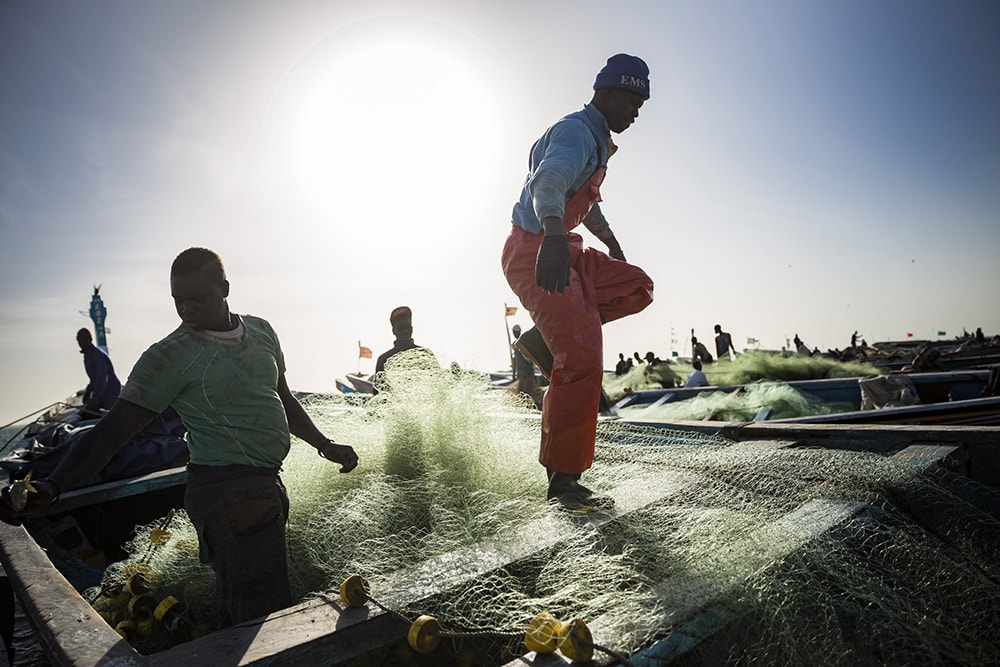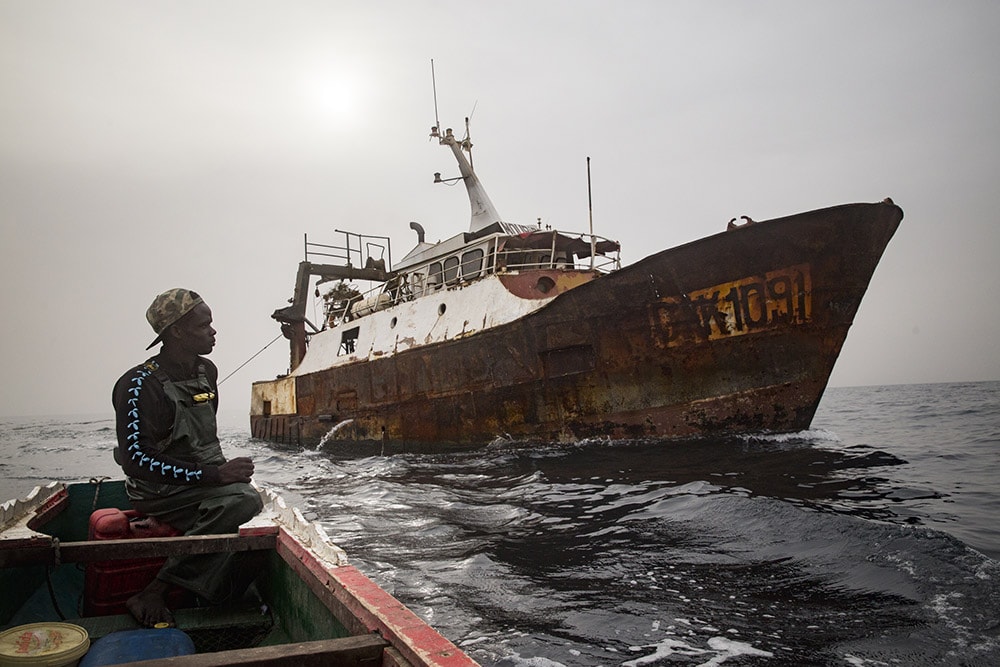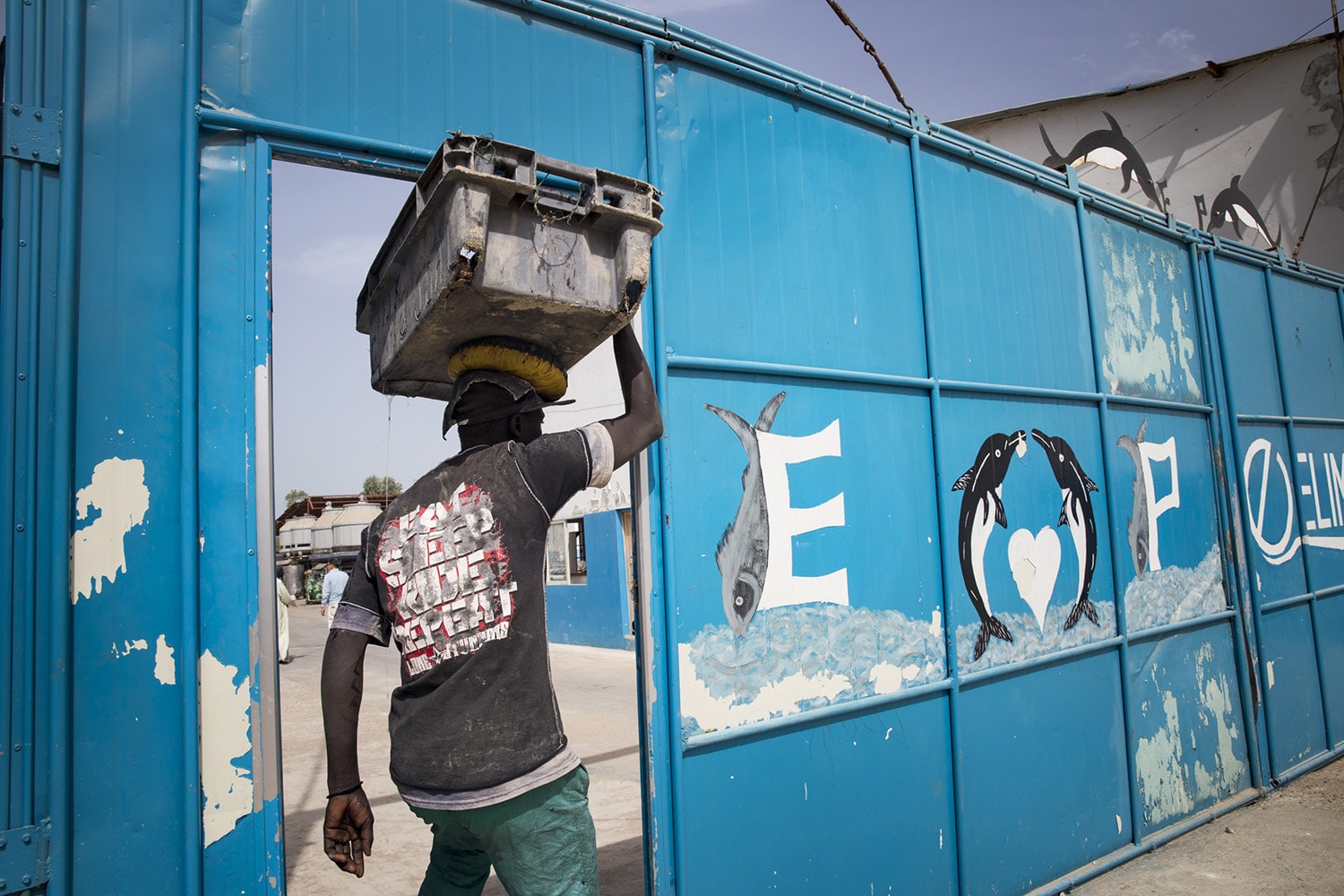Sall spends the majority of his time painstakingly removing fishermen’s nets from the small marine reserve he built.
“At this precise moment, there are 21,000 registered boats fishing along 718 kilometres of coast, using destructive practices: stationary nets or bottom trawling, longline fishing, harpoon or dynamite and monofilament fishing. Every species has been overfished.”
The situation has only been made worse by the onset of industrial fishing.
A young fisherman points to a boat anchored about 20 kilometres off the coast: “It’s a Spanish trawler. They don’t have the right to fish sardinella here. This is our fishing zone!”
The tiny fish are essential to food security in the region. Yet they are in high demand in Europe and Asia and have been targeted by Spanish, Russian and Chinese trawlers.
Traditional and industrial fishmeal plants have also sprung up along the coast, financed by Spanish, Russian, Chinese and Korean interests.
These plants, which dot the shores of Senegal and its neighbours Gambia and Mauritania, are reminiscent of the outposts that enriched Europe’s coffers during colonialism.
“The demand for fodder fish to feed salmon and carp has generated an extremely voracious industry that has monopolised fishing resources, because it takes 5 tonnes of sardinella to produce a single tonne of fish,” explained Gaoussou Gueye, president of the Confederation of Traditional Fishermen in West Africa.

Dedicated to conservation, Abdou Karim Sall has built a marine reserve along 30 kilometres of coastline. He spends his time patrolling the waters in a small boat to hunt down poachers.

Almost everyone uses nylon fishing nets, even though they’re officially banned. They’re less expensive and more efficient.

Because of a lack of oversight, industrial trawlers flying the Senegalese flag can fish as much as they want. They often register at a lower weight and fishing capacity, which allows them to work closer to the coast.

Fishermen rarely pull up stationary nets along Joal-Fadiouth’s coast. Trapped for several days, fish are often inedible by the time they are reeled in, and are used instead for fishmeal.

Fishmeal plants can pay as much as 4,000 West African CFA francs for 50 kilos of fish. Their product is then exported to China, Korea and the European Union.
In Senegal, fishmeal exports expanded from 990 tonnes in 2006 to 6,288 tonnes (or the equivalent of 31,440 tonnes of fresh fish) in 2015. A few years ago, a tonne of fishmeal was worth between $1,200 and $1,500 at most. It is now valued at between $1,800 and $2,100 per tonne, depending on the protein content.
Yet the local fishing community hasn’t profited from the windfall. Fishmongers, a job traditionally occupied by women, have been more or less pushed out of the market, unable to compete with factory prices and demand.
“Instead of fulfilling the needs of a population whose employment and food security depends on fish, Senegal has opted to invest in partially government-owned entities and industrial fish processing plants that are financed by the Koreans, Chinese or Spanish, who in turn benefit from looser regulations because their boats are registered under the Senegalese flag,” said Sall.
In Dakar, we saw around a dozen decrepit Chinese vessels flying the Senegalese flag anchored at an independent port, which had its own security and operated outside the control of Senegalese authorities.
These changes threaten the livelihood of the entire region, which depends on sardinella for jobs. They have also threatened a vital local resource: sardinella are at the bottom of a food chain that sustains other species, including humans.
In the end, Sall knows that his fight to protect his marine reserve from poachers is just a small drop in a much bigger ocean.
Yet the local fishing community hasn’t profited from the windfall. Fishmongers, a job traditionally occupied by women, have been more or less pushed out of the market, unable to compete with factory prices and demand.
“Instead of fulfilling the needs of a population whose employment and food security depends on fish, Senegal has opted to invest in partially government-owned entities and industrial fish processing plants that are financed by the Koreans, Chinese or Spanish, who in turn benefit from looser regulations because their boats are registered under the Senegalese flag,” said Sall.
In Dakar, we saw around a dozen decrepit Chinese vessels flying the Senegalese flag anchored at an independent port, which had its own security and operated outside the control of Senegalese authorities.
These changes threaten the livelihood of the entire region, which depends on sardinella for jobs. They have also threatened a vital local resource: sardinella are at the bottom of a food chain that sustains other species, including humans.
In the end, Sall knows that his fight to protect his marine reserve from poachers is just a small drop in a much bigger ocean.



